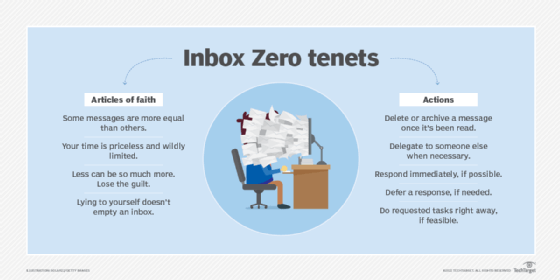Inbox Zero
What is Inbox Zero?
Inbox Zero is a rigorous approach to email management that aims to keep an inbox empty -- or almost empty -- at all times. It attempts to deal with the onslaught of email messages that fill inboxes to the point of overwhelming their recipients, making their work and personal lives more complicated and stressful, rather than easier.
Productivity expert Merlin Mann introduced the concept of "Inbox Zero" in 2006. According to Mann, the zero isn't a reference to the number of messages in an inbox, but rather "the amount of time an employee's brain is in his inbox." Mann's point is that time and attention are finite, and productivity suffers when an inbox is confused with a to-do list.
Shortly after Mann introduced the concept, he published what he called his five articles of faith:
- Some messages are more equal than others. On any given day, only a handful of emails are important and timely. Stop treating every email "like a Christmas present that must be savored."
- Your time is priceless and wildly limited. Few people have time to respond to every email they receive or even read them in detail. Accept that your workload exceeds your resources and slavishly guard your time.
- Less can be so much more. Quit thinking that one-line email responses are rude -- you're not helping anyone by sending wordy responses. When it comes to email, economy is key, at least for most messages.
- Lose the guilt. Out-of-control email is bad enough. Don't make it worse by beating yourself up because of your overflowing inbox. Forget the guilt and just get busy cleaning up the mess.
- Lying to yourself doesn't empty an inbox. Learn to be honest and realistic about your true priorities and time expectations, while developing a "baseline gut check on what you really intend to do about any given message."
Mann recommends emails be processed as soon as they're opened and not used as a to-do list. The goal is to handle an email in your inbox only once, if possible. To this end, Mann recommends one of the following five actions for each message:
- Delete (or archive). After you read the message, determine whether it requires any action or if it contains information you'll need to reference. If not, delete it or archive it.
- Delegate. You might find that the issues raised in the email would be better handled by someone else, in which case, you should forward the email to that individual and then delete or archive it.
- Respond. If you can answer the email in just a few lines, without spending more than a couple of minutes, respond immediately and then delete or archive the message.
- Defer. If a response requires more than a few minutes or will take a little work, defer your response until a more appropriate time. You might want to create a special folder to hold deferred emails until you can get to them.
- Do. If the email requires a task that can be completed right away, do it now and be done with it. Then archive or delete the message.

According to Mann, "There's no guarantee that this will be any kind of panacea for you." However, he said, many of us share a common set of errors and problems, "including a handful of terrible habits that have been reinforced by the most popular email programs." For this reason, he put forth several tips for effective email management that coincided with his five suggested actions:
- Don't leave the email client open.
- Process email periodically throughout the day, perhaps at the top of each hour.
- Delete or archive as many new messages as possible, and forward what can be best answered by someone else.
- Immediately respond to any new messages that can be answered in two minutes or less.
- Move new messages requiring more than two minutes to answer -- and messages that can be answered later -- to a separate "requires response" folder.
- Set aside time each day to respond to email in the "requires response" folder or chip away at email in this folder throughout the day.
The world of message management has become much more complicated with the arrival of text messages, social media messaging and other forms of electronic communication. According to Mann, communication overload is more common as people have multiple inboxes, including for work and personal email, in addition to social media and text messaging accounts. The need to deal effectively with all this clutter has never been greater. There's some debate as to how well Inbox Zero can be adapted to this new reality, but many of the concepts behind it can help drive more efficient message and time management.
Explore the role of mobile email management in the enterprise and effective ways to handle emails in a call center.
